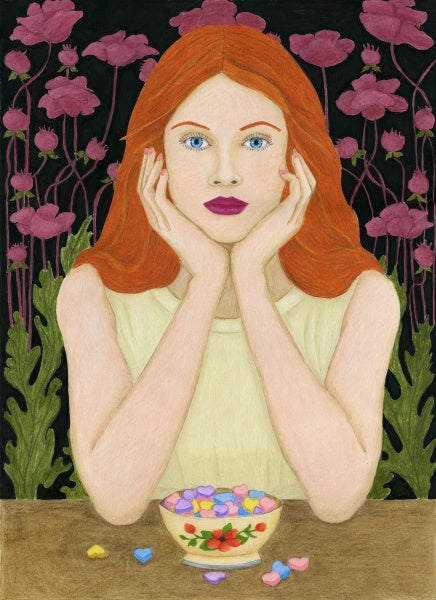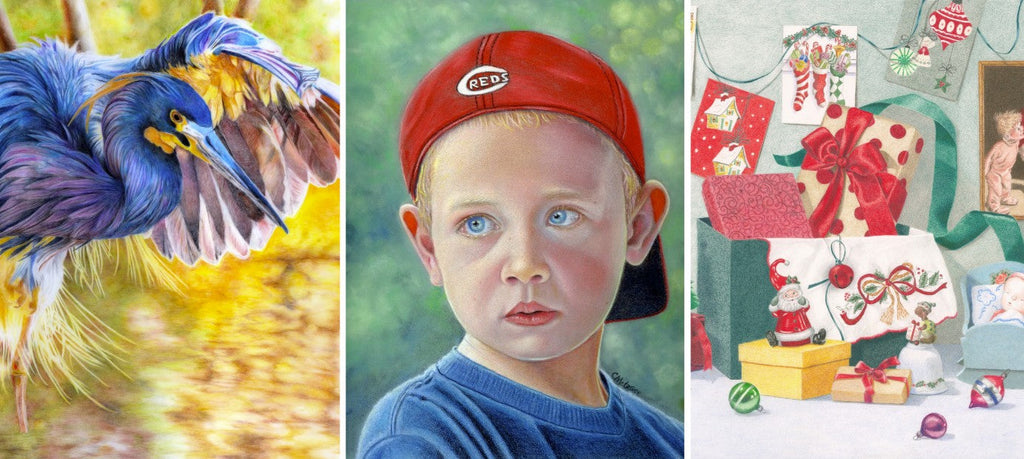From Squashed Pooh to the Royal Academy
by Robert Strange
I am a collector, a veritable magpie amongst artists. However, it’s not just shiny things that grab my attention; rather it is colorful, everyday objects that feed my growing obsession. Things like plastic bottle tops, dice, soft toys, ties, playing cards, toy vehicles, sweet wrappers, the list increases daily. My studio is a museum to ephemera displaying discarded items in jars and boxes, the strata of shelves looking like an art installation in themselves. It is these containers that are the inspiration for my art. As a child I enjoyed rummaging through the ‘odds-and-sods’ drawer that every household possesses; a drawer of paper clips and elastic bands, drawing pins and pens that don’t work.
As an adult I have these useless, thrown away pieces of tack on display, waiting to be immortalized in colored pencil and exhibited for a whole new audience to appreciate and to rediscover the beauty of the ordinary.

Squashed Pooh. Soft Toys in a glass-fronted box.
I start my drawing by randomly casting the chosen components into a glass-fronted container such as a fish tanks, anything that can have a grid drawn the front (using a permanent marker) to act as guidelines for the enlarging process. I use a 1 cm. square grid on the glass frontage and then draw a 2 cm., 3 cm. or larger grid on my paper. Each square is numbered using numbers along the top and letters down the side so I don’t lose my place when copying from the smaller grid to the larger. I draw on a heavy hot-press paper, 300gsm, which I place on a board in front of the container so that I can draw direct from the ‘still-life’. This drawing-out stage takes anything from 20 to 30 hours.
I worked as an art teacher for twenty years, and it was while developing a scheme of work for year eight pupils to help them with drawing skills that I came up with an idea to use the grid system of enlarging. Each pupil would choose objects from home that meant something to them and could fit into a jam jar. I believe in teaching by example, so I also collected some colorful toys, which I put into a larger glass-fronted box and proceeded to start a drawing that the pupils could see develop day by day. That was the first of many drawings in my ‘Squashed’ series of colored pencil work that continues to the present day.

Squashed Dice. Winner of the catalogue award at the Mall Galleries, London with the Pastel Society.
The colorful toys I used created a challenge to create the textures and colors accurately using colored pencil. I love using Prismacolor because they blend so easily, colors can be mixed on the paper, they can lay on top of each other to create translucent effects, they can be scratched into, scraped off and built up in layers to create the textures and patterns that I look for when drawing anything from rust to fabric, plastic to metal. They give an excellent coverage and solid color and I have often equated them to oil pastels such is the feeling I get when applying them to paper.
I recently achieved recognition of my work, and indeed of the appreciation of color pencil, when my drawing ‘Squashed Toy Vehicles’ was selected for the Royal Academy Summer Exhibition in London. It was the only colored pencil drawing in the whole of the show out of 800 works and to say I was delighted would be a vast understatement.
The drawing was from my collection of toy cars many of which have their paint work peeling off, broken and parts missing. It is this theme, of time taking its toll on objects, that inspires me to produce my artwork. When something is new it is treasured and appreciated. As it gets older it begins to lose its appeal and its usefulness. Newer models come along and it is soon put aside and eventually thrown away and forgotten.) What I try to achieve in my work is to rejuvenate those ‘somethings’, to make them important again. Being old doesn’t mean something is useless, unimportant or not beautiful. When my drawing was seen by thousands in the RA it was considered as a piece of art; old toy cars given a new lease of life. The same story can be told of all my 'Squashed' drawings; thrown away objects becoming important once more through the medium of color pencil.

Squashed Toy Vehicles. The only CP drawing at the Royal Academy this year.
The process of creating ‘Squashed Toy Vehicles’ involved using several different techniques: to obtain the patina of the vehicles I layered various shades of Prismacolor ‘Cool Grey’ on top of each other then, using a blade, I scraped them off leaving layers of different greys. I then burnished the surface and repeated this process a couple of times to create a patchy, multi-grey surface. By laying down a light color then putting a darker color on top I could create very thin lines using a scalpel to scratch through the top layer, a bit like sgraffito. Prismacolor are so adaptable but sometimes I needed a thin, hard pencil to draw detail with and for this I used Caran D’Ache Pablo pencils which sharpen to an excellent point and seem to work well with other pencils. I have a large set of 132 Prismacolor pencils which really helps when searching for a color but I had to mix several colors (greens and browns), on the paper itself to create the correct chroma of Khaki for the military vehicles. My next drawing will be toy bricks; a collectors work is never ending.
ABOUT ROBERT:
Robert Strange lives in Harwell, Oxfordshire. He is a member of the Oxford Art Society and the UKCPS. Robert has a BA (Fine Art) with Honours an MA in Art Education. He worked as a sign writer, graphic designer and free-lance artist before taking up a teaching post in a secondary school. He now works as a full-time artist including exhibiting, teaching and demonstrating. He has won the catalogue award from the Pastel Society and shown at the Royal Academy this year.
See more at: http://www.robert-strange.co.uk




